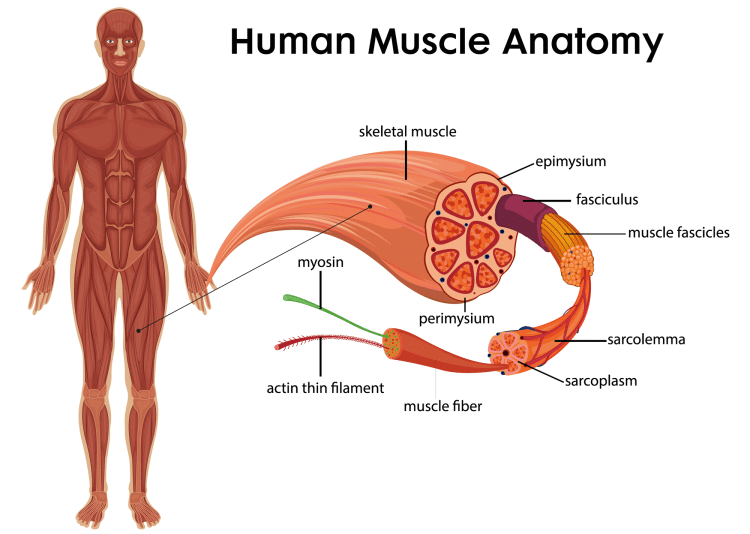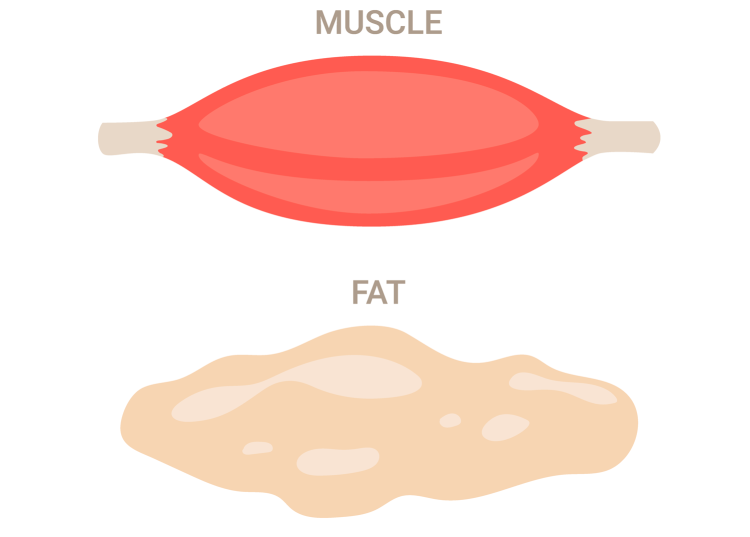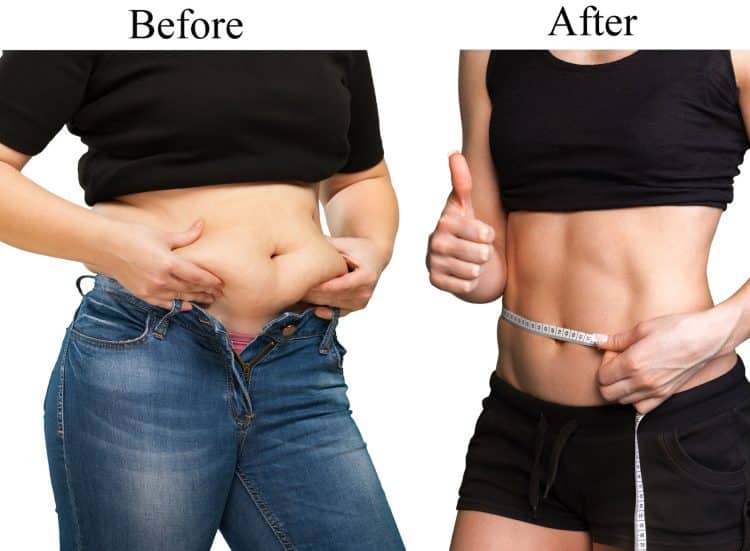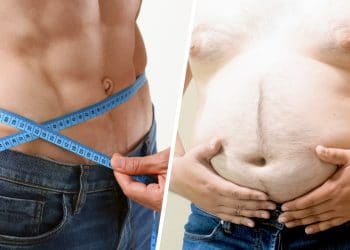Many exercisers judge their progress by their body weight. Religiously they hop on the scales, hoping to see their weight moving toward their goal. Whether you want to build muscle or lose fat, stalled scales can be a source of frustration, leaving you wondering if you need to change your diet or your workout – again.
Here’s the problem with relying on your weight to assess your progress: the scales cannot differentiate between fat, muscle, or any of the other substances that make up your total body mass.
As such, you could be succeeding despite the reading on the scale. For example, you could lose fat, gain muscle, and your weight remains unchanged. This may look like a failure on paper, but in reality, it will have a significant impact on how you look, feel, and perform.
In this article, we discuss the differences between fat and muscle, and how to really tell if you are making good progress.
An Introduction to Body Composition
When you get on your scales, whatever device you are using measures your total body mass. This includes whatever clothes you are wearing and any food in your digestive system.
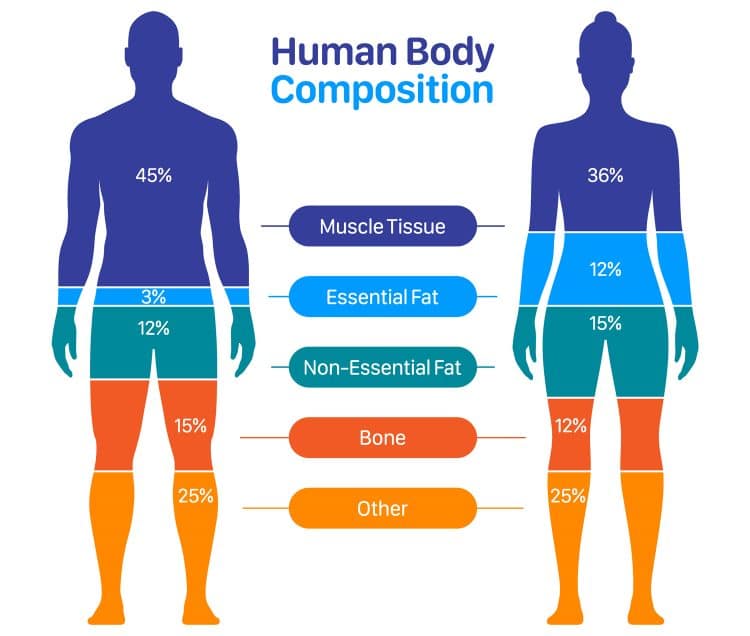
Level Up Your Fitness: Join our 💪 strong community in Fitness Volt Newsletter. Get daily inspiration, expert-backed workouts, nutrition tips, the latest in strength sports, and the support you need to reach your goals. Subscribe for free!
Broadly speaking, your body mass can be broken down into two components:
- Fat mass
- Fat-free mass (FFM)
The relationship between your fat mass and FFM mass is generally referred to as your body composition, which is expressed as a percentage. This percentage, e.g., 15%, is the amount of your total weight that’s made up of body fat. The remaining percentage is deemed to be your fat-free mass.
Your FFM can be sub-divided into several more components, including:
- Water
- Skin
- Organs
- Bones
- Substrates and chemicals
So, when you lose or gain weight, the quantities of any of these components could have changed. For example, you could be more or less hydrated, have more or less glycogen (stored glucose) in your liver and muscles, or have lost bone mass.
Your weight can even fluctuate throughout the day. Most people gain and lose several pounds each day. For example, you may weigh less after a workout because of dehydration but more after a meal because of the undigested food in your stomach. Most people are lightest on waking and heaviest at the end of the day.
However, none of these transitory changes means you’ve gained or lost muscle or fat. Instead, the only thing that has changed is your body weight. This is akin to weighing yourself naked and then fully clothed.
Because of all these potential variables, your weight is an unreliable indicator of your body composition. Instead, you need to be able to differentiate between changes in fat and fat-free mass. Body composition changes are MUCH more important than your body weight and tend not to fluctuate as much.
Related: FFMI Calculator: Find Your Fat Free Mass Index
Body Fat Basics
In simple terms, body fat is stored energy. When you eat too much food, your body converts it into fat for later use. Fat cells are called adipocytes, and body fat is stored as adipose tissue.
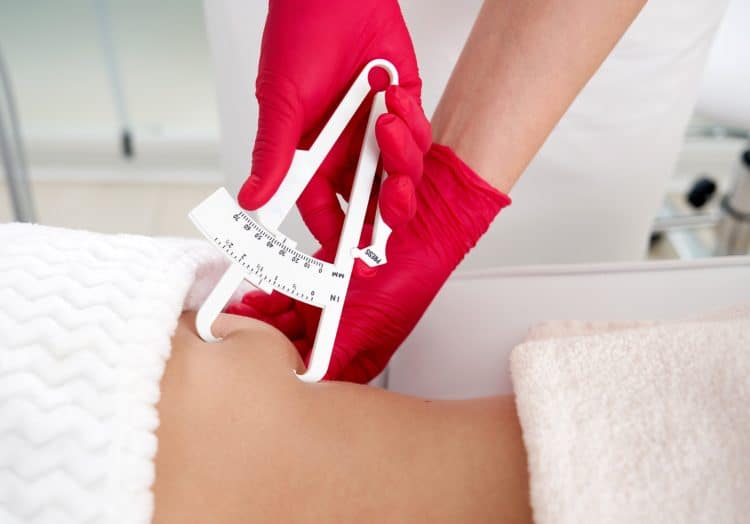
Then, if you fail to consume enough food and have insufficient energy, your body will release and burn body fat for fuel. It’s estimated that one pound of body fat contains around 3,500 calories.
However, body fat is more than just an inert substance your body can use for energy; it’s also an organ with several additional functions. That’s why very low body fat levels are often considered unhealthy and can even be dangerous; you NEED body fat to live and function correctly.
The additional functions of body fat include:
- Shape
- Insulation and temperature regulation
- Protection of internal organs, including the brain
- Storage and utilization of vitamins A, D, E, and K
- Protein utilization
- Hormone regulation, e.g., production of the satiety hormone leptin and the hunger hormone ghrelin
Body fat can be classified according to where it’s located in your body – visceral and subcutaneous (1). Visceral fat is stored around the internal organs and is considered to be a risk to health. Visceral fat is also known as belly fat and can only be accurately detected by MRI or CT scan.
In contrast, subcutaneous fat is found between the skin and muscles and presents less of a health risk than visceral fat. You can see and even pinch subcutaneous body fat. You also store a small amount of fat in your bone marrow.
Body fat can be divided into two more categories – white fat cells and brown fat cells.
White fat makes up the majority of fat in adults and is used for energy and energy storage. Brown fat, on the other hand, is mainly used for thermogenesis or heat production. Babies have a lot of brown fat and use it to stay warm in infancy, while adults tend to have less.
Because of its myriad functions, a certain amount of body fat is deemed essential, and lowering your body fat below this level could harm your health.
The percentage of essential body fat is:
- 2-5 percent for men
- 10-13% for women
While athletes can achieve very low levels of body fat, e.g., for bodybuilding competitions, they usually only maintain this level of extreme leanness for a few days or weeks. Then, out of season, they return to a more sustainable and healthy body fat percentage.
Try: Body Fat US Navy and Body Fat Skinfold Calculator
Muscle Basics
There are three types of muscle tissue in the human body. Each is highly specialized and has specific functions. The three types of muscle tissue are:
- Cardiac muscle – found in the heart
- Smooth muscle – used to make tubes and organs
- Skeletal muscle – responsible for movement
Of these three, skeletal muscle is the most important for body composition.
There are over 600 muscles in the human body, ranging from huge to tiny. For example, the gluteus maximus is the biggest skeletal muscle, the sartorius is the longest, and the stapedius, an auditory muscle, is the smallest. Some muscles are very well known, such as the biceps, while others are much less so, such as the quadratus lumborum.
Muscles are contractile, meaning they shorten to produce force. Innervated or controlled by motor nerves, muscles cross joints and are connected to your bones by tough fibrous cords and straps called tendons. Muscles are made up of bundles and bundles of muscle fibers. The smallest contractile unit of a muscle is called a sarcomere.
Broadly speaking, there are two types of muscles:
- Tonic
- Phasic
Tonic muscles produce low amounts of force for long periods to maintain your posture. They’re the endurance muscles of the human body. In contrast, phasic muscles produce force intermittently and on demand to produce movements. Phasic muscles tend to be more powerful but are quick to fatigue.
All muscle fibers fall into one of three types:
- Type 1a – also known as slow twitch muscle fibers. Type 1a fibers are red in color and have an excellent blood supply. They are very enduring but are not very strong, and nor do they have much potential for hypertrophy or growth.
- Type 2b – also known as fast twitch muscle fibers. Type 2b fibers are white and have a relatively poor blood supply. They’re very powerful but also tend to fatigue quickly. They have the greatest potential for hypertrophy.
- Type 2a – this type of fiber is trainable and adapts to the demands placed on them. They can become like type 1a or type 2b fibers depending on the kind of workouts you do. They can switch back and forth between jobs as required, e.g., if you quit lifting weights and take up running.
Your muscle fiber mix is determined by your genetics. Some people are slow-twitch dominant and naturally good at endurance activities such as long-distance cycling. Other people are equipped with more fast-twitch fibers and tend to be naturally stronger, faster, and more muscular.
Regardless of this, because of type 2b fibers, you can always train and improve your strength or endurance despite the dominance of one particular fiber type. However, your potential is limited by your genetics, which is why some people are better at certain sports than others.
Fat vs. Muscle – The Differences
Now you know a little more about fat and muscle, let’s take a moment to compare these two types of tissue:
Contractility
While you can flex and contract your muscles, you cannot contract fat. This is why someone can be big but weak or small but strong.
Sure, strongman competitors and some powerlifters carry a lot of body fat, but beneath that fat are some massive muscles. Many heavyweight lifters believe that “it takes mass to move mass,” and the extra weight can be helpful in dragging and pushing events.
Summary: Muscle contracts, while fat does not.
Blood Supply
Muscle tissue has e very good blood supply, even those muscles deemed to be fast twitch. This ensures they receive a steady supply of oxygen, and that carbon dioxide, the by-product of aerobic respiration, can easily be removed.
Blood supply increases with training, so even more, oxygen can be delivered to the working muscles. This is achieved through capillarization, which is the increase in the number of capillaries (thread-like veins) that supply the muscle.
Adipose tissue also has a blood supply. However, it tends to be lower than for muscle tissue.
Summary: Both muscle and fat have a blood supply. However, the blood supply to muscles tends to be greater.
Metabolic Activity
Metabolic activity is the amount of energy your body burns at rest. It’s also known as your basal metabolic rate, or BMR, and is expressed in calories per 24 hours. A higher BMR can make it easier to lose or maintain a healthy body weight and body fat percentage.
Muscle is more metabolically active than the same amount of fat. For example, it’s estimated that a pound of muscle uses 4-7 calories per hour. In contrast, a pound of fat uses just two (2).
Level Up Your Fitness: Join our 💪 strong community in Fitness Volt Newsletter. Get daily inspiration, expert-backed workouts, nutrition tips, the latest in strength sports, and the support you need to reach your goals. Subscribe for free!
As such, depending on body composition, two people who weigh the same can have very different resting metabolic rates, with the more muscular person burning more calories per 24 hours, even without added physical activity. This explains why some muscular people need to eat more to maintain their weight.
Summary: Muscle tissue burns 200-300% more calories than fat.
Density
Contrary to what many people believe, muscle is not heavier than fat, and a pound of fat and a pound of muscle both weigh one pound!
However, muscle IS denser than fat. This means a pound of muscle takes up less space than a pound of fat. Because of this, you can lose fat, gain muscle, and completely change your clothing size despite your body weight remaining relatively unchanged.
Fat has a density of about 0.9g/cm3, and muscle has a density of 1.06g/cm3 (3+4). So, if you put one pound of muscle and one pound of fat on a scale, there would be more fat than muscle.
Summary: Muscle is roughly 10% more dense than fat. As such, fat takes up more space than the same amount of muscle.
How to Tell If You Are Gaining or Losing Fat or Muscle
Because of things like fat vs. muscle density and how changeable your body weight can be, it’s clear that the scales are not a reliable way to assess your progress. In fact, the scales can tell you are failing when, in fact, you are knocking it out of the park and making significant changes to your body composition.
So, how can you tell if you are gaining or losing fat or muscle? Use the following strategies and discover the truth.
Get a body composition assessment
Body composition assessments determine your body fat percentage. There are several assessment options to choose from, all offering varying degrees of accuracy. But, at the end of your test, you will have an estimate of your body fat percentage.
Assessment options include:
- Hydrostatic (underwater) weighing
- Skinfold calipers
- DEXA scan
- Bioelectrical impedance
- Near-infrared interactance
- Online body composition calculators
Monitoring your body fat percentage over the coming months will reveal if you are losing or gaining fat or muscle.
You’re gaining weight but losing inches
Gaining or maintaining weight while losing inches, e.g., around your hips or waist, is an excellent indicator that you are shedding fat while building muscle. Remember, muscle is denser than fat, so fat takes up more space on your body. The process of losing fat while gaining muscle is often called recomping.
Read more about recomping here.
You’re getting stronger
Strength increases are a good indicator that you’re building muscle. After all, muscle is contractile tissue, whereas body fat is not.
However, you can also get stronger because of improved neurological function and better lifting technique. That said, if your lifts are increasing from week to week, it’s a safe bet that at least some of your progress is due to increased muscle mass.
Conversely, while the occasional bad workout doesn’t mean much, if you are getting consistently weaker, you could be losing muscle. Although, consistent training should make this less of a likelihood.
Your muscle definition is improving
Has the outline of your abs started to emerge? Can you see some separation between your quadriceps or deltoids? Are your veins more visible? Congratulations – this strongly suggests your body fat percentage is starting to fall.
Most of your body fat is subcutaneous, i.e., between your skin and muscles. As your levels of subcutaneous body fat decrease, there will be less tissue between your skin and your muscles, so the underlying musculature will become more visible.
The best way to see and track this is with progress photos.
Remember, though, your definition will worsen if you gain body fat. So, if your abs and veins are fading away, it may be because your body fat levels are starting to rise.
Changes in clothing size
Your clothes are an excellent way to measure your progress. For example, if your pants are getting loose around the waist, it’s safe to say you are losing fat. Conversely, if they’re getting tight, you are probably gaining fat.
Your belt notch is often a much better indicator of body composition changes than your scales.
Body composition assessments are the most accurate way to determine if you are gaining or losing fat or muscle. However, you can also use things like your clothing sizes, gym performance, and definition to assess your progress.
While these things aren’t as quantifiable as body composition testing, they will tell you subjectively if your muscle and fat mass are changing, which is something the scales cannot do.
Fat vs. Muscle Weight – FAQ
Do you have a question about fat vs. muscle weight or body composition? No problem, because we’ve got the answers!
1. Can I lose fat and build muscle at the same time?
Contrary to what many people think, you can gain muscle while losing fat. As you know, fat and muscle are entirely different things, and they exist independently. As such, you can burn fat for energy and use that energy to work out and build muscle.
However, it is worth noting that pursuing these two goals simultaneously often means slower progress than focusing on one goal at a time, i.e., bulking and then cutting.
2. What is the ideal body fat percentage?
The ideal body fat percentage varies from person to person. For example, a competitive male bodybuilder may get their BF% as low as five percent for a competition. In contrast, a heavyweight powerlifter could be strongest with their body fat at 30%.
As such, your body fat percentage should match your goals. That said, the accepted fat percentages by gender and age are:
| Sex | Age | Low | Normal | High | Very High |
| Female | 20 – 39 | < 21 | 21.0 – 32.9 | 33.0 – 38.9 | 39 |
| 40 – 59 | < 23 | 23.0 – 33,9 | 34.0 – 39,9 | 40 | |
| 60 79 | < 24 | 24.0 – 35.9 | 36.0 – 41.9 | 42 | |
| Male | 20 – 39 | < 8 | 8.0 – 19.9 | 20.0 – 24.9 | 25 |
| 40 – 59 | < 11 | 11.0 – 21.9 | 22.0 – 27.9 | 28 | |
| 60 – 79 | < 13 | 13.0 – 24.9 | 25.0 – 29.9 | 30 |
3. Is it possible to be fat and fit?
Having a high body fat percentage doesn’t mean you can’t be fit. There are many examples of overweight athletes performing incredible feats of strength and endurance. Football, baseball, wrestling, boxing, and field athletes are often heavy, and yet they compete at the highest level of their chosen sports.
That said, there is a massive difference between being fit and being healthy. Fit means you can handle the demands of your chosen activity, while healthy means the absence of disease. As such, it’s entirely possible to be fit but unhealthy.
For example, being over-fat can increase your risk of diabetes, heart disease, and hypertension, all of which can shorten your life.
So, yes, you CAN be fat and fit, but it’s much harder to be fat and healthy.
4. What is the best body recomposition workout and diet?
Body recomposition involves losing fat while building muscle. Invariably, achieving these goals consists of a combination of strength training, cardio, and an intelligent diet.
Strength training is critical for maintaining or increasing muscle mass and is usually involves a bodybuilding-style program. Cardio helps burn fat by expending additional calories. In addition, your diet needs to support training, recovery, and muscle growth while reducing your calorie intake to promote fat burning.
While it’s beyond the scope of this article to tell you how to achieve body recomposition, you can read all about it in these two articles:
5. What are the best exercises for burning fat and building muscle?
The best exercises for body recomp are challenging, burn a lot of calories, and provide plenty of overload for the target muscles. They are usually compound in nature, meaning they use multiple joints and muscles together.
Good examples include:
- Squats
- Deadlifts
- Bench press
- Overhead presses
- Pull-ups/chin-ups
Exercises that combine two or more movements are also good options for body recomp. Examples include:
- Front squat to push-press (thrusters)
- Clean to overhead press
- Sumo deadlift high pull
- Burpees
- Clusters (squat clean and thruster)
Read more about the best body recomp exercises here.
Fat vs. Muscle Weight – Closing Thoughts
While there is nothing wrong with keeping track of your body weight, the scales don’t tell the whole truth about your progress. In fact, they can be very misleading and even make you think your workouts and diet are failing you.
That’s because the scales cannot tell the difference between fat and muscle weight, and, as you know, these are very different substances.
Tracking your body composition is much more accurate and will reveal far more about your progress.
So, stop living and dying by your daily weigh-ins. Instead, pay more attention to how your clothes fit, your waist measurement, your gym performance, and your muscle definition. Better yet, get a body composition assessment and discover your true body fat percentage.
After all, your weight doesn’t really matter, and it’s what that weight is made up of that counts.
Related:
- How to Burn 400 Calories a Day
- How to Burn 1000 Calories A Day
- How To Lose 1 Pound a Day
- How To Lose 15 Pounds in a Month
- Losing 50 Pounds in 6 Months
- How to Lose 10 Pounds in a Week
- Weight Management 101: How to Calculate Macros
References:
- Mittal B. Subcutaneous adipose tissue & visceral adipose tissue. Indian J Med Res. 2019 May;149(5):571-573. doi: 10.4103/ijmr.IJMR_1910_18. PMID: 31417024; PMCID: PMC6702693. https://www.ncbi.nlm.nih.gov/pmc/articles/PMC6702693/
- University of New Mexico: Controversies in metabolism https://www.unm.edu/~lkravitz/Article%20folder/metabolismcontroversy.html
- Abe T, Thiebaud RS, Loenneke JP. The mysterious values of adipose tissue density and fat content in infants: MRI-measured body composition studies. Pediatr Res. 2021 Nov;90(5):963-965. doi: 10.1038/s41390-021-01376-y. Epub 2021 Jan 27. PMID: 33504969. https://pubmed.ncbi.nlm.nih.gov/33504969/
- Ward SR, Lieber RL. Density and hydration of fresh and fixed human skeletal muscle. J Biomech. 2005 Nov;38(11):2317-20. doi: 10.1016/j.jbiomech.2004.10.001. Epub 2004 Dec 30. PMID: 16154420. https://pubmed.ncbi.nlm.nih.gov/16154420/

